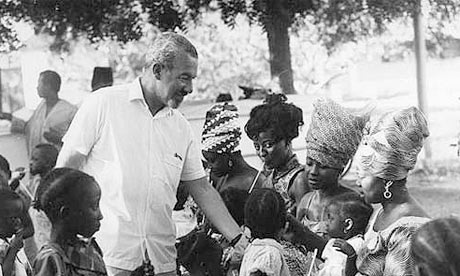
Leslie Collier in the Gambia.
"Professor Leslie Collier, who has died aged 90, was a virologist and bacteriologist who played a key role in eradicating smallpox. He worked out a way of freeze-drying smallpox vaccine so that it could be carried into remote areas in high temperatures. He also made the crucial link between trachoma, affecting 84 million people worldwide, of whom about 8 million are visually impaired, and the sexually transmitted disease chlammydia.. His work changed the method of treatment for patients with trachoma, saving eyesight and many lives.
The world was at the mercy of the smallpox virus when Leslie began his research at the Lister Institute of Preventive Medicine, then in Chelsea, London, in 1948. In the early 1950s, an estimated 50m cases of smallpox occurred each year. A vaccine existed, but it would deteriorate within three days of being taken out of a refrigerator. Vaccination visits to remote villages in sub-Saharan Africa and South America had been pointless.
Leslie's breakthrough meant that, for the first time, teams of vaccinators were not dependent on refrigerators. A vaccinator could paddle a canoe into a tropical forest or hike across mountains carrying a simple kit containing a vial of freeze-dried vaccine (enough to vaccinate 200 people), saline solution to reconstitute the freeze-dried vaccine powder, a pot for boiling needles and two plastic tubes – one for clean needles and one for used needles. Importantly, it could also be mass-produced.In 1967, the World Health Organisation decided to harness the potential of Leslie's vaccine and stamp out smallpox for good. It seemed a near-impossible task: 60% of the world's population then still lived in countries where smallpox was endemic. Unicef bought the vaccine in bulk and distributed it to those who needed it. By the mid-1970s, as many as 150,000 people were engaged in the task of finding infected villages and persuading their sometimes hostile inhabitants to accept the vaccination. By 1980, the WHO was able to announce that smallpox had been eradicated.
Twenty-five years later, an international smallpox meeting was hosted at Barts and the Royal London hospital to mark the anniversary of the last natural case of smallpox, in a hospital cook called Ali Maalin from Somalia. Leslie gave the keynote talk, although he didn't mention his contribution. I wasn't surprised. When we had written Human Virology (1993) together, Leslie wrote the chapter on smallpox and I wrote the chapter on influenza. When it came to the time for us to read each other's work, I was puzzled – to put it mildly – not to find a mention of him in his own chapter. That was typical of Leslie.In fact Leslie had two firsts, whereas most of us would be quite content with one. The Chinese had already isolated a psittacosis-like bacterium from the eyes of trachoma patients (until then, the disease was thought to be caused by a virus). Leslie's trachoma research units in Chelsea and the Gambia confirmed this work by infecting blind human volunteers with tiny doses of chlamydia trachomatis. He found that chlamydia did indeed cause the disease. This would open the door to new treatments. Leslie was proud to be awarded the Chibret gold medal from the Ligue Contre Le Trachome in 1959.
Ironically, it was his diminishing eyesight that most upset Leslie in his last months. I will miss the afternoons at his flat near the Royal College of Physicians, Regent's Park, and our quiet literary criticisms of each other's writing. I always dreaded a small cough from him. "I don't think the students will understand this, John," he would say. He was usually right. Ours was a friendship bred from viruses, disease and vaccines.Leslie was deputy director of the Lister Institute from 1968 to 1974 and director of the vaccines and sera laboratories at Elstree, Hertfordshire, from 1974 until their closure in 1978. He was professor of virology at the University of London from 1966 to 1988 and a consultant pathologist at the Royal London hospital from 1987.
He was a devoted editor of the classic bacteriology textbook Topley & Wilson's Principles of Bacteriology, Virology and Immunology (now Topley & Wilson's Microbiology and Microbial Infections). He was also joint editor of Developments in Antiviral Chemotherapy (1980). A fellow of the Royal Society of Pathologists, Leslie was president of the pathology section of the Royal Society of Medicine from 1986 to 1988.
In 1942, he married the film-maker Adeline Barnett, who survives him. Leslie was predeceased by their son David. "
Article written by John Oxford
